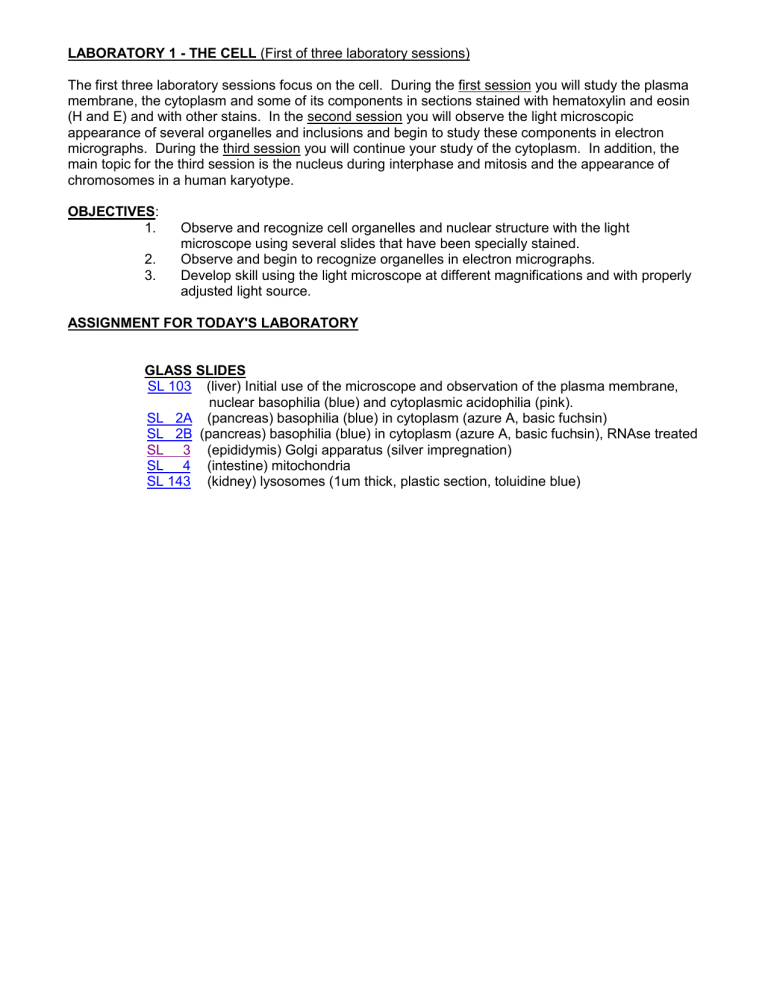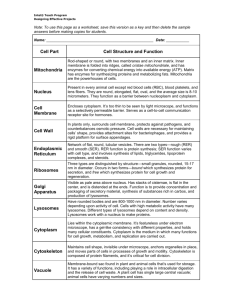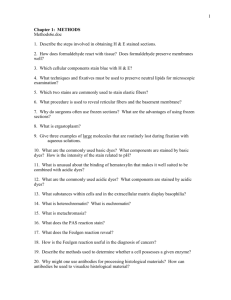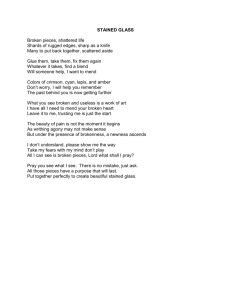laboratory 1

LABORATORY 1 - THE CELL (First of three laboratory sessions)
The first three laboratory sessions focus on the cell. During the first session you will study the plasma membrane, the cytoplasm and some of its components in sections stained with hematoxylin and eosin
(H and E) and with other stains. In the second session you will observe the light microscopic appearance of several organelles and inclusions and begin to study these components in electron micrographs. During the third session you will continue your study of the cytoplasm. In addition, the main topic for the third session is the nucleus during interphase and mitosis and the appearance of chromosomes in a human karyotype.
OBJECTIVES :
1. Observe and recognize cell organelles and nuclear structure with the light microscope using several slides that have been specially stained.
2. Observe and begin to recognize organelles in electron micrographs.
3. Develop skill using the light microscope at different magnifications and with properly adjusted light source.
ASSIGNMENT FOR TODAY'S LABORATORY
GLASS SLIDES
SL 103 (liver) Initial use of the microscope and observation of the plasma membrane, nuclear basophilia (blue) and cytoplasmic acidophilia (pink).
SL 2A (pancreas) basophilia (blue) in cytoplasm (azure A, basic fuchsin)
SL 2B (pancreas) basophilia (blue) in cytoplasm (azure A, basic fuchsin), RNAse treated
SL 3 (epididymis) Golgi apparatus (silver impregnation)
SL 4 (intestine) mitochondria
SL 143 (kidney) lysosomes (1um thick, plastic section, toluidine blue)
I. LIGHT MICROSCOPY
Today you will use the light microscope to observe the cell membrane and the appearance of the cytoplasm and the nucleus of cells in sections of tissue that have been stained with hematoxylin and eosin (H and E) or other stains. As you look at the slides with the different objectives of your microscope, make changes in the light adjustment and diaphragm to see how the image is affected.
During your study, as questions arise check with your lab instructors. This exercise will introduce you to use of your microscope. In the next laboratory session you will begin to analyze electron micrographs.
NOTE: THERE ARE REFERENCES TO ILLUSTRATIVE MATERIAL THROUGHOUT THIS MANUAL.
THE ILLUSTRATIONS WILL BE FOUND IN YOUR ATLAS AND IN YOUR TEXTBOOK. PLEASE
REFER TO THESE BOOKS DURING THE LABORATORY:
THIS VIRTUAL LABORATORY MANUAL CONTAINS A DDRESSES (URL’S) FOR DIGITAL IMAGES
OBTAINED FROM THE SLIDE COLLECTION THAT WILL AID YOU IN ANALYZING THE SECTIONS
ON THE GLASS SLIDES.
ATLAS: R = ROSS AND PAWLINA, Histology: A Text and Atlas, 6 th
ed., 2011.
TEXT: J = JUNQUEIRA, et al., Basic Histology, 12 th
ed., 2010
1. PLASMALEMMA OR PLASMA MEMBRANE The plasma membrane forms the outer boundary of cells and consists of trilaminar, unit membrane.
Light Microscope - SL 103 (Liver) ( J . Fig. 16-12; R . Plate 65 and 66). On this slide, the area of interest is the liver, which is the large dark tissue in the upper right portion of the digital slide. In this organ the predominant cell type is the liver (red circle) cell. In these cells the cytoplasm is pale pink and the nuclei are round and stained deep blue. Fine dark lines separate the lightly stained areas of cytoplasm in adjacent cells (blue arrows) . The width of a single plasma membrane (9 nm) is below the limit of resolution of the light microscope, since under optimal conditions a structure must have a width or diameter of about 200nm to be observed. However, when two plasma membranes are juxtaposed and/or when cytoplasmic proteins have been precipitated (fixed) against the membranes, their general location can be determined as a dark line as in this slide.
CYTOPLASMIC ORGANELLES The cell's organelles are located in the cytoplasm or cytosol, i.e. between the nuclear membrane (nuclear envelope) and the plasma membrane. Routine stains such as hematoxylin and eosin do not make the organelles readily visible, but may allow some of them to be localized. For the following slides, special methods have been used to allow the organelles to be observed.
2. RIBOSOMES
Light Microscope - SL 2A and SL 2B Pancreas (Azure A and Basic Fuchsin). The two sections on this slide, (one at each end of the slide) show the location of ribosomes and demonstrate of the distribution of RNA and DNA within cells. As you observe the section that appears more intensely blue (SL 2A), you will find that many cells have specific regions of cytoplasm that have stained deeply blue. This basophilia represents the distribution of RNA, primarily the structural
RNA of the ribosomes stained with Azure A. In this case, most of the ribosomes are attached to rough endoplasmic reticulum.
The chromatin (DNA) in each nucleus stains red to purple. (FYI….When treated with warm HCl deoxyribose, DNA forms aldehyde groups, but ribose does not. Therefore the DNA, but not
RNA is stained by the Basic Fuchsin.) By using the oil immersion objective, it might be possible to locate nucleoli in the nucleus of some of the blue stained cells. Careful observation of these nucleoli will allow you to detect the blue stained RNA that they have synthesized.
To confirm that the blue stained material on this slide is in fact RNA, compare this section with the one on the other end of the slide ( SL 2B ) that was treated with the enzyme ribonuclease prior to staining. Note that the blue-stained material has either been eliminated or
drastically reduced by digestion with this enzyme whereas the DNA has not. Basophilia in the cytoplasm of cells is usually an indication of their ability to synthesize proteins.
3. GOLGI APPARATUS
Light Microscope – SL 3 Rat epididymis ( scan , silver impregnation, H & E counterstain). This tissue is composed of a long coiled tube that when sectioned appears as many flattened sacs and tubes in different orientations. With low magnification, locate one tube, switch to the high dry objective and examine this tube. Note that as the magnification increases, the field of view decreases. Whereas the center of the tube contains “stringy” material, the perimeter is composed of cells lying next to each other. These cells constitute an epithelium. Identify the blue stained nuclei near the base of each cell (away from the tube's lumen). Observe the black material that is situated between the nucleus and the top (apex) of the cells. This black material is the Golgi apparatus (blue circles) . Its appearance is caused by precipitation of silver on the membranes that form the structure. In some cells the region occupied by the Golgi apparatus appears empty when the tissue is stained with routine procedures. The clear space observed is referred to as the Golgi ghost (J. Fig. 5-7; R. Fig. 2.32)
4. MITOCHONDRIA - Mitochondria are the main source of ATP within the cell.
Light Microscope - SL 4 (iron hematoxylin stain) - Rat small intestine (iron hematoxylin). Using the low power objective, find one finger-like (a villus) projection (enclosed by blue line) and center it in your field of view. Switch to high dry (carefully) and identify the cells covering this projection. These are columnar-shaped cells (enclosed by blue line) , i.e. elongated cells with an oblong nucleus. Center one edge on a small region of columnar cells, add oil, switch to the 100
X oil immersion objective and focus the oil immersion lens.
WARNING: ONCE THERE IS OIL ON THE SLIDE, BE CAREFUL NOT TO SWITCH BACK TO THE
40X (HIGH DRY) OBJECTIVE WITHOUT FIRST REMOVING THE IMMERSION OIL FROM THE
SLIDE. IF OIL GETS ON THE 40X OBJECTIVE, IT WILL NOT FOCUS PROPERLY WITHOUT
CAREFUL CLEANING .
With this type of preparation, not all cells will demonstrate mitochondria; therefore you must scan along these cells until you find one with thin black elongated thread-like structures in its apical cytoplasm. These structures are the mitochondria . Compare these mitochondria to other mitochondria located below the nucleus (red and blue circles) . Close examination may reveal that the mitochondria near the cell surface are elongated, while the mitochondria below the nucleus are round. Don't be confused by the large prominent black areas, - these are precipitated stain and incidental cells that did not destain in the process of making the slide.
The pale oval areas towards the bases of the cells are unstained nuclei.
5. LYSOSOMES
This organelle is bounded by a single membrane. The hydrolytic enzymes within lysosomes are active in degradation of the enclosed substances.
Light Microscope - Lysosomes can be visualized by staining specifically for acid phosphatases.
As you may recall, many different acid hydrolases are found in lysosomes, but the acid phosphatases in particular serve as useful markers because they are virtually always present in lysosomes and the histochemical demonstration of these enzymes is a routine procedure.
Lysosomes are also visible as stained granules in some specialized cells of the blood that will be studied later.
SL 143 - Section of rat kidney (J. 2-24) - Plastic embedded section; 1
m thick stained with
Toluidine Blue. This is the type of preparation that is used for orientation of a section prior to detailed EM studies of organs. Within this section numerous circular structures (kidney tubules)
( low , med ) may be seen using the 44 x objective (enclosed by red line) (enclosed by red line).
Several different types of tubules are evident. One type of tubule is formed from rather large cells. Within the cytoplasm of these large cells distinct, blue-staining "granules" of varying sizes are visible (green circles) . These granules are lysosomes that may be observed at the level of the light microscope. For a more detailed study of the lysosomes, switch to the 100 x (red arrows) objective (oil immersion).
OBJECTIVES FOR LABORATORY 1: THE CELL I
1. Make sure you are familiar with the use of your light microscope and the digital slides, including changing magnification, light intensity, etc.
2. Using the light microscope or digital slides, identify:
Cells
Plasma membrane
Nucleus
Cytoplasm
Extracellular material (just in genera l for now…the area outside cells)
Other organelles you observed today (ribosomes, Golgi, mitochondria, lysosomes) can only be definitively identified if you are provided information about the stain that was used and what that stain specifically targeted.
3. Have a good understanding of typical staining techniques. a. Recognize hematoxylin and eosin (H&E) staining (e.g. SL 103), including how structures within the cell are stained by this technique. In this regard, you should immediately recognize H&E stained slides, and recognize how parts of the cells, tissues, and organs stain with this technique. For example, for today’s lab, how do each of the structures listed under #2 above appear on H&E staining? What is meant by the terms basophilic and eosinophilic, and which structures in the cell are basophilic? Eosinophilic? You will want to do this for each item listed in the objective section under light microscope identification in all future labs. Also, note you will find that different cell types stain slightly differently with H&E, so you should recognize those as well as they are introduced to you. b. The only other stain you will be completely responsible for recognizing, including identifying structures by how they appear in tissues stained in this manner, is Periodic acid-Schiff (PAS) (see Lab 5, e.g. slide 19). You will want to immediately recognize slides stained with PAS, know the colors of structures stained positively using the PAS method, and know which components of cells or extracellular matrix stain positively using this method. c. You may see tissues stained by other techniques on the exam, but you will either be given specifics on the staining technique used if necessary, or will be asked a question in which the exact nature of the staining technique is not needed to provide the correct answer. For example, for the most part, you should recognize the nucleus of a cell regardless of which staining technique is used (as long as you can see it).








